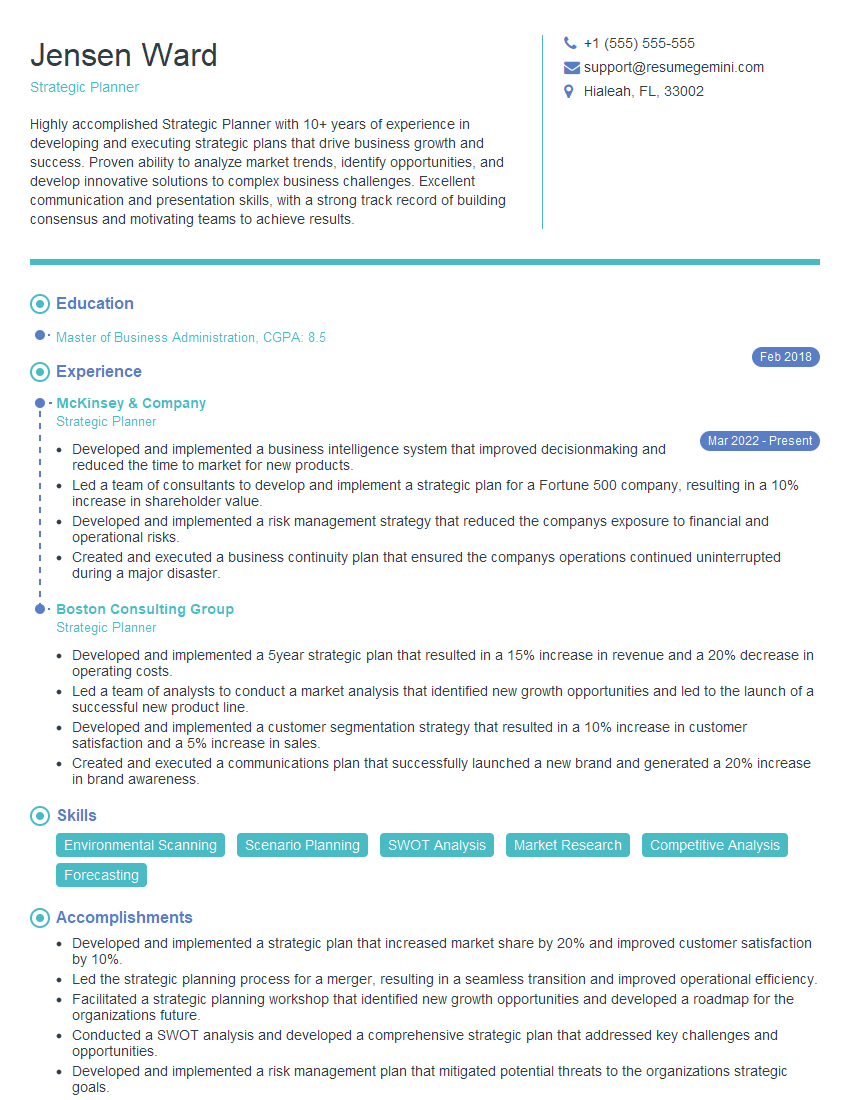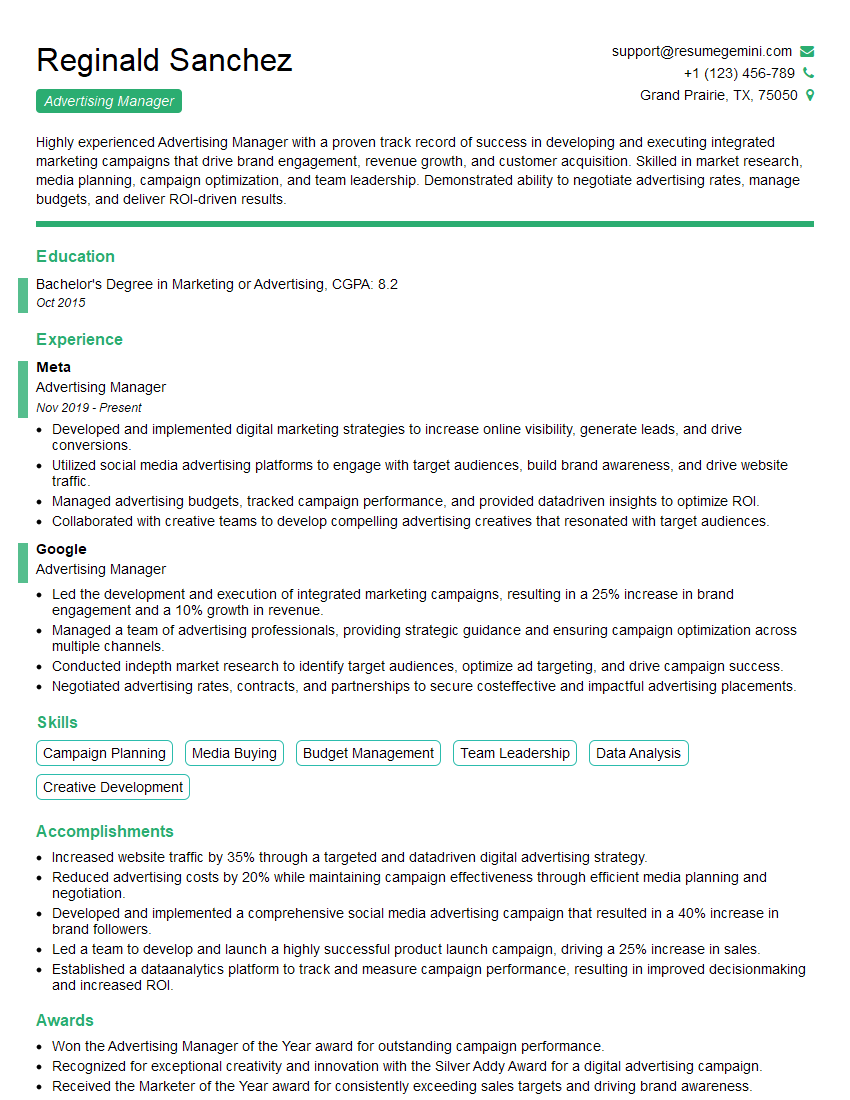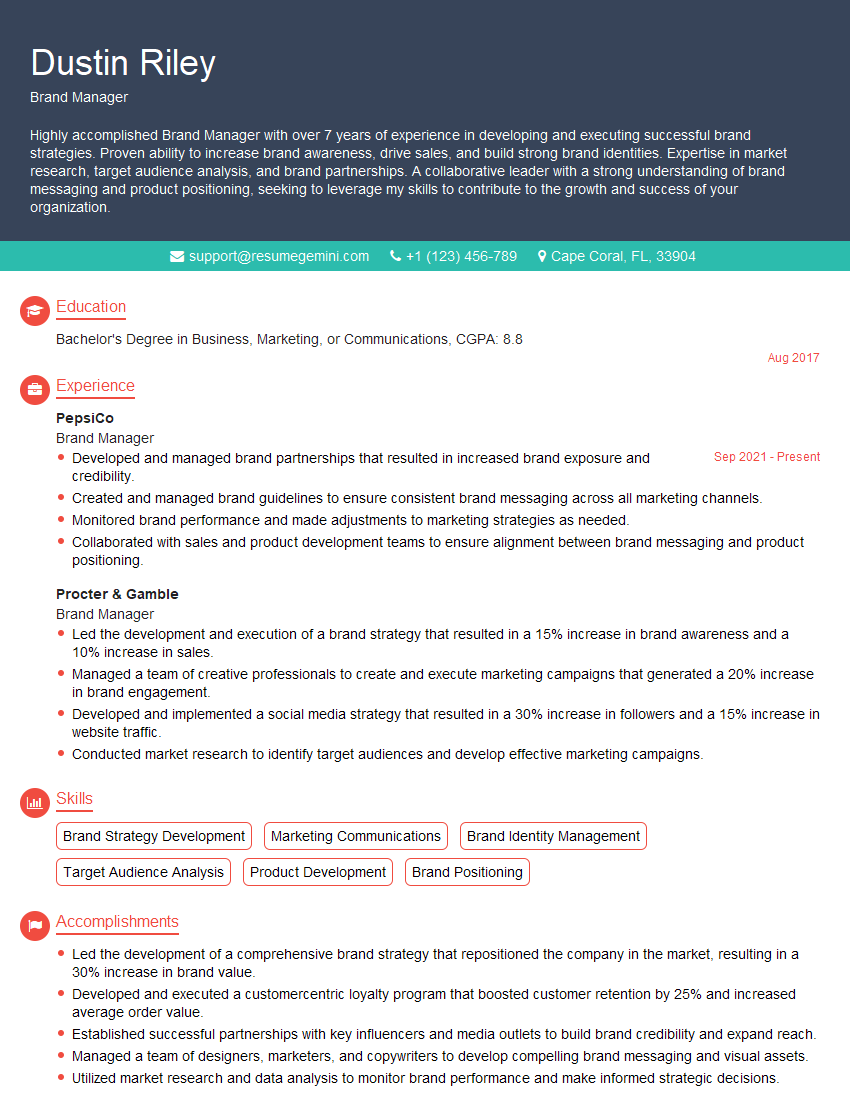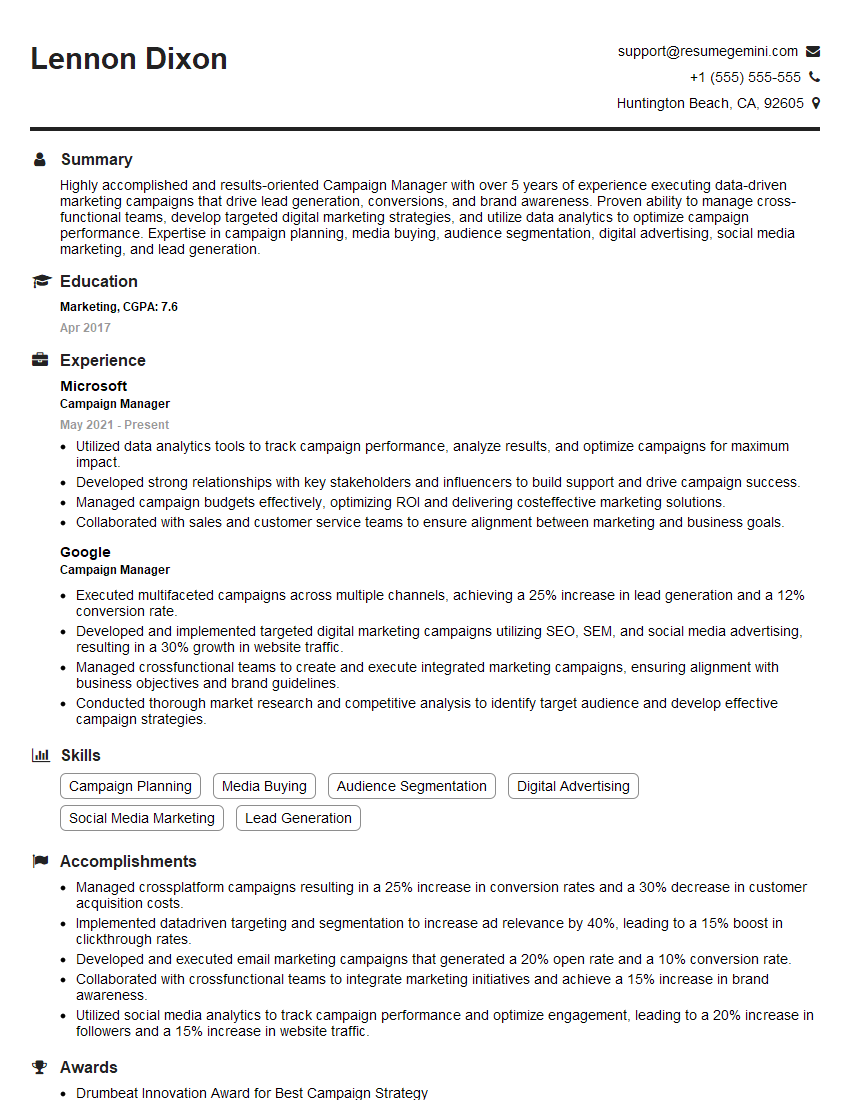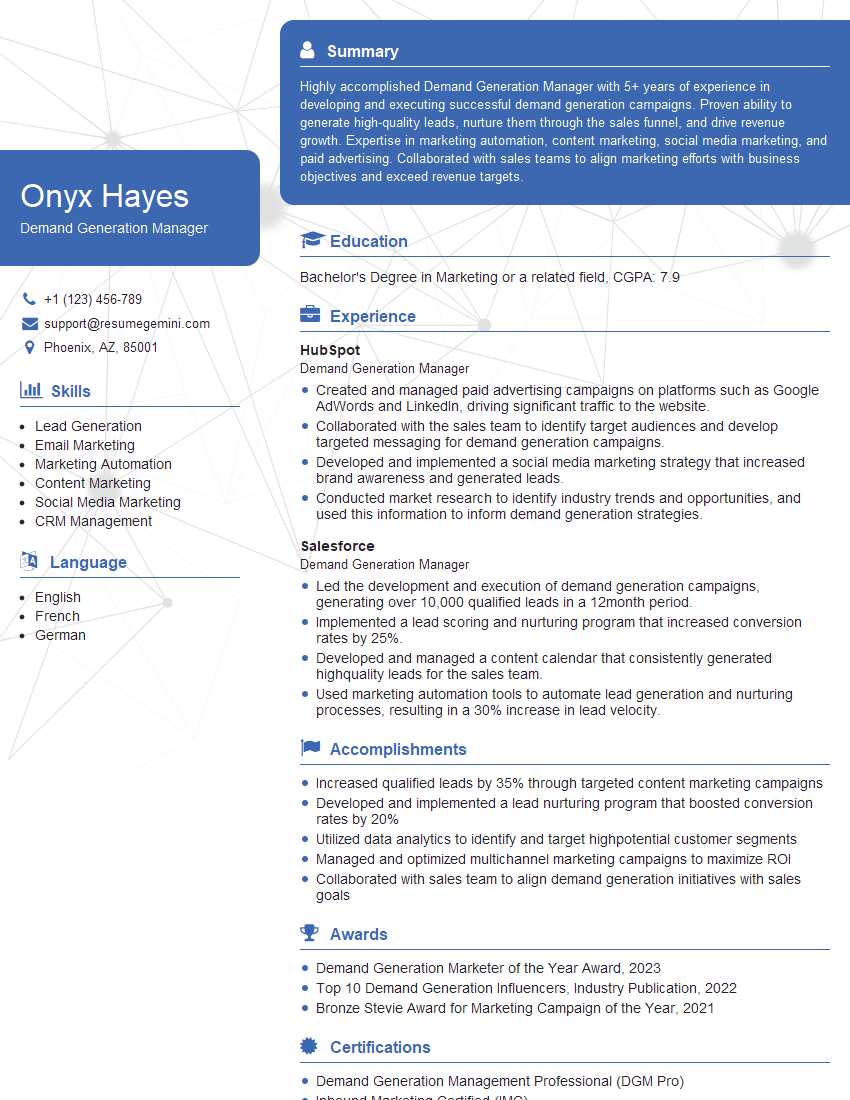Feeling uncertain about what to expect in your upcoming interview? We’ve got you covered! This blog highlights the most important Pitch Framing Metrics interview questions and provides actionable advice to help you stand out as the ideal candidate. Let’s pave the way for your success.
Questions Asked in Pitch Framing Metrics Interview
Q 1. Define Pitch Framing Metrics. Provide three examples.
Pitch framing metrics are quantifiable measures that assess how effectively a marketing pitch communicates its value proposition and resonates with the target audience. They help understand whether the message is clearly understood, engaging, and persuasive. These metrics go beyond simple sales figures; they delve into the audience’s perception and interaction with the pitch.
- Net Promoter Score (NPS): Measures customer loyalty and willingness to recommend a product or service after exposure to the pitch. A higher NPS indicates a more positively framed pitch.
- Click-Through Rate (CTR): For digital pitches, CTR measures the percentage of recipients who clicked on a call to action (CTA) within the pitch. A high CTR suggests the pitch successfully captured attention and generated interest.
- Engagement Rate (on social media): This metric measures the level of interaction (likes, comments, shares) a pitch receives on social media platforms. Higher engagement suggests the pitch was compelling and relevant to the audience.
Q 2. How do you measure the effectiveness of a pitch using framing metrics?
Measuring pitch effectiveness using framing metrics involves a multi-faceted approach. It’s not just about a single metric but analyzing several in conjunction. For example, a high CTR alone doesn’t guarantee effectiveness. You also need to consider:
- Conversion Rate: How many clicks translate into actual sales or desired actions. A low conversion rate despite a high CTR indicates a disconnect between the pitch and the CTA.
- Qualitative Feedback: Customer surveys, focus groups, and social media comments offer invaluable insights into how the audience perceived the message. This helps identify areas for improvement.
- A/B Testing: Comparing the performance of different pitch versions (with varying messaging or visuals) helps identify the most effective framing. Analyzing the metrics for each variation reveals what resonates best.
By holistically analyzing these metrics, you get a comprehensive picture of your pitch’s effectiveness. It’s about understanding not just *if* the audience is interacting, but *why* and *how* that interaction impacts your overall goals.
Q 3. Explain the difference between leading and lagging pitch framing metrics.
Leading and lagging metrics differ in their timing relative to the marketing activity and the desired outcome. Think of it like this: lagging metrics are the *results* while leading metrics are the *indicators* of future results.
- Lagging Metrics: These metrics reflect the *outcomes* of your pitch. They typically appear after the pitch has been delivered and the audience has had time to react. Examples include sales conversions, customer acquisition cost (CAC), and return on investment (ROI). They tell you what happened, but not necessarily *why*.
- Leading Metrics: These metrics provide *early indicators* of potential success. They measure engagement and audience response *during* and immediately *after* pitch exposure. Examples include website traffic, social media engagement, email open rates, and CTRs. They offer insights into the audience’s immediate reaction and predict future lagging metric performance.
Understanding both is crucial; leading metrics help you optimize your pitch *before* significant resources are invested, while lagging metrics provide a final assessment of its success.
Q 4. What are some common pitfalls to avoid when using pitch framing metrics?
Several pitfalls can hinder the accurate interpretation and use of pitch framing metrics:
- Ignoring Qualitative Data: Relying solely on quantitative data without considering qualitative feedback (surveys, interviews) can lead to inaccurate conclusions.
- Focusing on Vanity Metrics: Prioritizing metrics that sound impressive but don’t directly contribute to business goals (e.g., high social media impressions without engagement) is ineffective.
- Ignoring Context: Metrics should always be analyzed within the context of the campaign’s objectives, target audience, and industry benchmarks.
- Poorly Defined Goals: Without clear goals, it’s impossible to determine which metrics are truly relevant and how to interpret the results.
- Data Silos: Not integrating data from different platforms prevents a holistic view of the pitch’s performance.
Avoiding these pitfalls requires a strategic and holistic approach to data analysis, emphasizing both quantitative and qualitative insights.
Q 5. How do you identify the most relevant pitch framing metrics for a specific campaign?
Identifying the most relevant metrics begins with defining your campaign objectives. Ask yourself:
- What is the primary goal of this campaign? (e.g., brand awareness, lead generation, sales conversion)
- Who is the target audience? (their demographics, online behavior, and preferences will influence relevant metrics)
- What channels are being used? (different channels have different relevant metrics)
Once these are defined, select metrics directly linked to the objectives. For example:
- Brand Awareness Campaign: Focus on reach, impressions, social media engagement, and media mentions.
- Lead Generation Campaign: Prioritize form submissions, CTA clicks, email sign-ups, and lead nurturing metrics.
- Sales Conversion Campaign: Track sales conversions, conversion rates, average order value (AOV), and customer lifetime value (CLTV).
By aligning metrics with your goals, you can effectively measure the success of your pitch framing.
Q 6. Describe a situation where you used pitch framing metrics to improve a marketing campaign.
In a recent campaign for a new software product, our initial pitch focused heavily on technical features. While the CTR was high, the conversion rate remained disappointingly low. Analyzing qualitative feedback (customer surveys and online comments), we discovered the messaging was too technical and didn’t resonate with the target audience, who were primarily non-technical professionals.
We revised the pitch to emphasize the software’s ease of use and its impact on improving workflow efficiency. We also A/B tested different versions of the visuals and messaging. By tracking engagement metrics (CTR, time on page, video views) alongside conversion rates, we found that the revised pitch, emphasizing ease of use and benefits, resulted in a significant increase in both engagement and conversions.
The initial high CTR was a deceptive leading indicator. The qualitative data and A/B testing, combined with a focus on the right lagging metrics, allowed for successful campaign optimization.
Q 7. What is the relationship between pitch framing metrics and overall marketing ROI?
Pitch framing metrics are intrinsically linked to overall marketing ROI. Effective pitch framing directly impacts the efficiency and effectiveness of marketing efforts.
A well-framed pitch leads to higher engagement, increased conversions, and ultimately, a greater return on investment. By optimizing the pitch based on the metrics, you minimize wasted resources and maximize the impact of your marketing spend. For example, a high conversion rate resulting from an improved pitch directly increases revenue and decreases customer acquisition cost (CAC), both key components of ROI calculation.
In essence, robust pitch framing metrics provide the data-driven insights necessary to continuously optimize campaigns, leading to improved marketing ROI and better resource allocation.
Q 8. How do you adjust your pitch framing metrics based on audience segmentation?
Adjusting pitch framing metrics based on audience segmentation is crucial for maximizing impact. Different audiences respond to different messaging styles and value propositions. For example, a pitch for a complex software solution to a team of engineers will differ significantly from a pitch to a group of executives focused on ROI. We segment audiences based on factors like industry, company size, job title, technical expertise, and even personality traits inferred from prior interactions. Once segmented, we tailor our key metrics. For engineers, we might prioritize metrics like technical feasibility and integration ease, tracking things like time to implementation and error rates. For executives, we focus on metrics like return on investment (ROI), cost savings, and market share impact. This tailored approach ensures we’re measuring the right things to gauge success within each segment.
For instance, we might measure ‘click-through rate’ (CTR) on a marketing email for a broad audience, but for a specific segment of high-value prospects, we might prioritize ‘meeting booked rate’ as a more relevant metric. This ensures that our efforts are truly optimized for each targeted audience.
Q 9. Explain how A/B testing can be used to optimize pitch framing metrics.
A/B testing is indispensable for optimizing pitch framing metrics. It allows us to test different versions of our pitch—varying messaging, visuals, and even the order of information—and measure which performs better against our key metrics. We might test two different headlines, two different calls to action, or even two entirely different approaches to the same value proposition. By randomly assigning prospects to either version A or version B, we can eliminate bias and accurately compare performance. We track metrics like conversion rates, engagement (time spent on the pitch materials), and ultimately, the desired outcome, like deal closure or product adoption.
For example, we could A/B test two versions of a sales presentation: one focusing on cost savings and the other on increased efficiency. By tracking conversion rates for each version, we could determine which framing resonated more effectively with our target audience and refine future pitches accordingly.
Q 10. How do you incorporate customer feedback into your pitch framing metrics analysis?
Customer feedback is invaluable for refining our pitch framing metrics and ensuring they accurately reflect what resonates with our audience. We actively solicit feedback through surveys, post-pitch interviews, and reviews. This qualitative data helps us understand the ‘why’ behind the quantitative results from our metrics tracking. For example, a low conversion rate might be explained by customer feedback indicating confusion over a particular feature or pricing model. This feedback might prompt us to adjust our pitch to clarify these aspects and subsequently track the impact of these changes on our conversion rate.
We use sentiment analysis tools to process larger volumes of feedback, identifying common themes and areas for improvement in our messaging and pitch structure. This iterative process allows for continuous improvement and ensures that our pitch framing remains customer-centric and effective.
Q 11. What are some common tools or software used for tracking pitch framing metrics?
Several tools and software facilitate tracking pitch framing metrics. For example, CRM systems (like Salesforce or HubSpot) can track key metrics like conversion rates and deal sizes. Marketing automation platforms (like Marketo or Pardot) provide detailed insights into email open rates, click-through rates, and engagement with pitch materials. A/B testing platforms (like Optimizely or VWO) simplify the process of creating and managing A/B tests. Analytics dashboards (like Google Data Studio or Tableau) allow us to visualize and analyze data from multiple sources, creating comprehensive reports for stakeholders.
Furthermore, specialized sales intelligence platforms provide deeper analysis of prospect interactions and provide predictive insights to optimize pitch framing based on specific account behavior.
Q 12. How do you present pitch framing metrics to stakeholders effectively?
Presenting pitch framing metrics to stakeholders effectively requires clarity and a focus on the key takeaways. We avoid overwhelming them with raw data; instead, we focus on the story the data tells. We use visual aids like charts and graphs to highlight key trends and insights. We present the results in a clear, concise manner, emphasizing the business impact of our findings. We tailor our presentation to the audience, ensuring that the complexity of the data is appropriate for their level of understanding. We always relate the metrics back to overall business goals, showing how improved pitch framing contributes to revenue growth, customer acquisition, or other key objectives.
A well-structured presentation might begin with a summary of key findings, then delve into the specific metrics, and conclude with recommendations for future actions.
Q 13. Describe a time you had to defend your pitch framing metrics approach.
In one instance, we introduced a new metric—’time to proposal’—to measure the efficiency of our sales process. Some stakeholders argued that this metric wasn’t relevant, focusing solely on the closing rate. I defended our approach by showing data correlating faster proposal times with higher closing rates. I presented a scatter plot demonstrating a clear positive correlation; shorter proposal times predicted a significantly higher chance of deal closure. Additionally, I highlighted the operational benefits of reduced proposal time, freeing up sales representatives to focus on other prospects. This combination of data-driven evidence and a focus on the broader business impact effectively convinced the stakeholders of the value of our new metric.
Q 14. How do you handle conflicting pitch framing metrics data?
Conflicting pitch framing metrics data necessitates a thorough investigation. We start by validating the data’s accuracy and ensuring consistent methodologies across different data sources. We examine potential biases in our data collection or analysis. We look for underlying factors that might explain the discrepancies. For example, one metric might show a positive response to a particular change, while another shows a negative one. This might indicate that the positive response is concentrated in a particular customer segment, while the negative response is concentrated in another, highlighting the importance of audience segmentation. By exploring these factors, we can develop a more nuanced understanding of the data and reconcile seemingly conflicting results.
If discrepancies persist despite thorough investigation, we might use a weighted average approach, assigning higher weight to metrics that are considered more reliable or relevant based on our understanding of the business context. Transparency is key—we clearly document our analysis and methodology, acknowledging the limitations and uncertainties.
Q 15. What are some ethical considerations when using pitch framing metrics?
Ethical considerations in using pitch framing metrics are crucial to avoid manipulation and ensure fairness. We must prioritize transparency and avoid misleading audiences. For example, selectively highlighting only positive data while ignoring negative aspects is unethical. Similarly, using emotionally charged language or framing statistics in a way that distorts their true meaning is deceptive. It’s essential to present a balanced and accurate picture, even if it doesn’t perfectly align with the desired outcome. We should always consider the potential impact our messaging has on the audience and ensure we’re not exploiting vulnerabilities or creating unrealistic expectations.
- Transparency: Clearly disclose the methodology used in collecting and analyzing data.
- Objectivity: Present both positive and negative findings without bias.
- Avoidance of manipulation: Refrain from using emotionally charged language or deceptive framing to influence the audience.
- Data privacy: Protect the privacy of individuals whose data is used in the analysis.
Career Expert Tips:
- Ace those interviews! Prepare effectively by reviewing the Top 50 Most Common Interview Questions on ResumeGemini.
- Navigate your job search with confidence! Explore a wide range of Career Tips on ResumeGemini. Learn about common challenges and recommendations to overcome them.
- Craft the perfect resume! Master the Art of Resume Writing with ResumeGemini’s guide. Showcase your unique qualifications and achievements effectively.
- Don’t miss out on holiday savings! Build your dream resume with ResumeGemini’s ATS optimized templates.
Q 16. How do you ensure the accuracy and reliability of your pitch framing metrics data?
Ensuring accuracy and reliability in pitch framing metrics involves a multi-step process starting with meticulous data collection. We use validated survey methods, ensuring representative samples and minimizing bias. For example, we might use A/B testing to compare different pitch framings. This controlled environment helps isolate the impact of the framing. Data cleaning is equally vital—identifying and handling outliers and inconsistencies in the data to avoid skewing results. Finally, rigorous statistical analysis is employed to draw meaningful conclusions. We might use methods like regression analysis to understand the relationship between different framing elements and the desired outcome. The entire process is meticulously documented and regularly audited to maintain the highest levels of quality control.
- Validated survey methods: Use established techniques to minimize bias.
- A/B testing: Compare different framing approaches in controlled experiments.
- Data cleaning: Identify and handle outliers and inconsistencies.
- Statistical analysis: Employ appropriate methods to draw meaningful conclusions.
- Documentation and auditing: Maintain detailed records of the entire process.
Q 17. What are some emerging trends in pitch framing metrics?
Emerging trends in pitch framing metrics include a growing focus on incorporating AI and machine learning. These technologies can help analyze large datasets of unstructured data, such as social media conversations and customer reviews, to identify subtle nuances in how a pitch is perceived. This allows for a more granular understanding of audience response. Another key trend is the increased emphasis on emotional intelligence. We’re moving beyond simple quantitative measures to understand the emotional impact of a pitch – analyzing sentiment, identifying emotional triggers, and measuring the overall emotional resonance of the message. This holistic approach provides a richer, more nuanced picture of effectiveness. Finally, there’s a shift towards personalized pitch framing, leveraging data to tailor the message to individual audience segments based on their unique needs and preferences.
Q 18. How do you use pitch framing metrics to inform future marketing strategies?
Pitch framing metrics are instrumental in informing future marketing strategies. By analyzing the data, we can identify which framing approaches resonate best with our target audiences and which ones fall flat. For instance, if data shows that a particular framing increases engagement significantly, we can incorporate that approach into future campaigns. Conversely, if a certain framing consistently leads to negative feedback or low conversion rates, we can modify or abandon it altogether. This data-driven approach ensures that our marketing efforts are as effective and efficient as possible. It allows us to allocate resources optimally, focusing on approaches proven to yield the highest return on investment.
For example, if we find that a benefit-driven framing is significantly more effective than a feature-driven framing, we can adjust our marketing messaging accordingly for future campaigns.
Q 19. Explain the importance of setting clear goals before tracking pitch framing metrics.
Setting clear goals before tracking pitch framing metrics is essential for effective measurement and optimization. Without defined objectives, collecting data becomes a meaningless exercise. Imagine trying to navigate without a destination – you’ll gather lots of data, but it won’t lead anywhere useful. Clear goals provide a framework for choosing the right metrics to track. If our goal is to increase sales conversions, we’ll focus on metrics like click-through rates and conversion rates. If our objective is to enhance brand awareness, we’ll focus on metrics like social media engagement and website traffic. The clearer our goals, the more effectively we can interpret the data and use it to improve our strategies.
Q 20. How do you interpret different types of pitch framing metrics (e.g., quantitative vs. qualitative)?
Interpreting different types of pitch framing metrics requires a balanced approach. Quantitative metrics provide concrete numerical data, such as website conversion rates or social media shares. These numbers offer clear evidence of a pitch’s impact. However, they alone may not tell the whole story. Qualitative metrics provide context and insight into the ‘why’ behind the numbers, often gathered through surveys, interviews, or focus groups. For instance, a low conversion rate (quantitative) might be explained by negative customer feedback highlighting confusing messaging (qualitative). Integrating both provides a complete understanding. Think of it as having both a map (quantitative data) and a travelogue (qualitative data) – each offers a different, yet vital, perspective on the journey.
Q 21. How can you use pitch framing metrics to measure the effectiveness of different marketing channels?
Pitch framing metrics can be used to measure the effectiveness of various marketing channels by comparing the performance of the same pitch across different platforms. For example, we might test the same pitch on social media, email marketing, and paid advertising. By tracking metrics like click-through rates, engagement levels, and conversion rates for each channel, we can determine which channel is most effective in delivering our message and generating the desired response. This allows for informed resource allocation, focusing investments on the channels with the highest ROI. For instance, if email marketing consistently outperforms social media in terms of lead generation, we can shift resources to optimize the email marketing strategy.
Q 22. What are the limitations of using only pitch framing metrics to evaluate a marketing campaign?
Relying solely on pitch framing metrics to assess a marketing campaign’s success is limiting because it provides a narrow perspective. Pitch framing, while crucial for understanding how your message resonates and influences perception, doesn’t capture the entire picture. It focuses primarily on the communication aspect, neglecting vital factors like market size, competition, budget allocation, and overall business goals. For instance, a perfectly framed pitch might fail to yield results if the target market is too small or if the product itself has inherent flaws. A more holistic evaluation must incorporate metrics like conversion rates, customer acquisition cost (CAC), return on investment (ROI), brand awareness changes (measured through surveys or social listening), and website traffic. In short, while pitch framing helps refine the what and how of communication, other metrics are needed to evaluate the overall impact and effectiveness on business objectives.
Q 23. How can you improve the efficiency of your pitch framing metrics tracking process?
Improving the efficiency of pitch framing metrics tracking involves a multi-pronged approach. First, automate data collection wherever possible. Tools like social listening platforms, CRM systems, and marketing automation software can automatically capture data on sentiment, engagement, and conversions, reducing manual effort. Second, standardize your metrics. Defining clear, consistent metrics across different campaigns ensures comparability and facilitates trend analysis. For example, always use the same sentiment analysis tool and the same scoring system. Third, integrate your tracking systems. Connect your various data sources – website analytics, CRM, social media – to create a centralized dashboard for real-time monitoring and analysis. Fourth, regularly review and refine your metrics. What worked for one campaign might not work for another. Regularly assessing the effectiveness of your chosen metrics helps to eliminate redundancies and improve the overall process. Finally, employ A/B testing to compare different pitch framings and identify the most effective approaches.
Q 24. Describe a time when you had to change your approach to pitch framing metrics due to unexpected results.
During a campaign for a new sustainable energy product, our initial pitch framing, focusing heavily on environmental benefits, yielded unexpectedly low engagement. We initially assumed the message wasn’t compelling enough. However, further analysis revealed that the target demographic, while environmentally conscious, was primarily concerned with cost-effectiveness and long-term savings. We changed our approach by shifting the pitch framing to highlight the long-term financial benefits alongside the environmental advantages. This adjustment included recalibrating our metrics to track not just engagement but also conversions based on cost-benefit comparisons. This revised approach led to a significant increase in engagement and ultimately, better conversion rates. The experience taught us the importance of thorough audience research and adapting our framing to directly address the primary concerns of our target market. It also underscored the importance of flexibility and iterative improvement when working with pitch framing metrics.
Q 25. How do you incorporate pitch framing metrics into a larger business intelligence strategy?
Pitch framing metrics are an integral part of a comprehensive business intelligence (BI) strategy. They contribute crucial insights into customer perception, message resonance, and campaign effectiveness. Within a broader BI framework, pitch framing metrics are integrated by connecting them to other key performance indicators (KPIs). For example, we can correlate sentiment scores from social media (a pitch framing metric) with sales figures (a traditional BI metric) to understand how positive messaging translates to actual revenue. Data visualization tools can help illustrate these relationships, creating dashboards that show the combined impact of marketing efforts across different touchpoints. This integrated approach allows for a more holistic understanding of marketing ROI and informs strategic decision-making. Ultimately, pitch framing metrics provide context and nuance to the broader quantitative data, making the BI analysis more insightful and action-oriented.
Q 26. How do you identify and address bias in your pitch framing metrics data?
Addressing bias in pitch framing metrics requires a proactive and multifaceted approach. First, be aware of potential biases inherent in the data collection methods. For example, relying solely on social media sentiment might overrepresent the opinions of a specific demographic. Second, use multiple data sources to triangulate information and reduce reliance on a single potentially biased source. Third, employ rigorous data cleaning and pre-processing techniques to remove outliers and inconsistencies. Fourth, carefully consider the wording of surveys and questionnaires to avoid leading questions or biased framing. Fifth, utilize techniques to mitigate algorithmic bias in sentiment analysis tools. Finally, regularly review and audit your data collection and analysis processes to identify and correct potential sources of bias. Transparency and careful methodology are key to ensuring the reliability and validity of your findings.
Q 27. How do you explain complex pitch framing metrics data to non-technical audiences?
Explaining complex pitch framing metrics to non-technical audiences requires clear, concise communication and visual aids. Avoid jargon and technical terms. Instead, use simple analogies and relatable examples. For instance, instead of saying “sentiment analysis shows a negative correlation between messaging and engagement,” you could say “when we used this specific message, people reacted less positively, and this affected how much they interacted with our campaign.” Use charts and graphs to visually represent the data, making trends and patterns easy to understand. Focus on the key takeaways and actionable insights rather than getting bogged down in the details. Highlight the business implications of the data, emphasizing how the findings inform decisions and contribute to the overall success of the marketing campaign. Keeping it simple, visually engaging, and focused on the business impact is crucial for effective communication.
Q 28. How do you use pitch framing metrics to demonstrate the value of your marketing efforts?
Pitch framing metrics directly demonstrate the value of marketing efforts by quantifying the impact of messaging on key performance indicators. By showing how changes in message framing correlate with improvements in brand perception, engagement, and ultimately, conversions, you provide concrete evidence of marketing ROI. For example, if A/B testing demonstrates that a specific pitch framing leads to a 20% increase in click-through rates or a 15% increase in conversion rates, this directly translates to increased sales and revenue. Furthermore, improved brand sentiment, as measured through pitch framing metrics, can demonstrate positive brand equity, contributing to long-term value. By presenting these tangible results, pitch framing metrics prove the effectiveness of the marketing investment and justify further investment in similar strategies. Data visualization helps to present these findings in a clear, compelling manner, strengthening the narrative around the value of marketing.
Key Topics to Learn for Pitch Framing Metrics Interview
- Defining Pitch Framing Metrics: Understand the core concepts and various types of metrics used to measure the effectiveness of a pitch, including engagement, conversion, and sentiment analysis.
- Practical Application: Learn how to select and interpret relevant metrics based on specific campaign goals and target audience. Consider case studies of successful pitch framing and the metrics that contributed to their success.
- Data Analysis and Interpretation: Develop skills in analyzing data from various sources (e.g., A/B testing, surveys, social media analytics) to identify trends and inform pitch optimization strategies.
- Attribution Modeling: Grasp the complexities of attributing success to specific elements of a pitch. Understand different models and their implications for decision-making.
- Reporting and Communication: Practice effectively communicating your findings and recommendations to stakeholders using clear visualizations and compelling narratives.
- A/B Testing and Experimentation: Understand the principles of A/B testing and its application to pitch optimization. Develop strategies for designing robust experiments and analyzing results.
- Ethical Considerations: Discuss responsible use of data and the ethical implications of pitch framing metrics in different contexts.
Next Steps
Mastering Pitch Framing Metrics is crucial for career advancement in today’s data-driven world. Demonstrating a strong understanding of these metrics significantly enhances your value to any organization. To boost your job prospects, focus on creating an ATS-friendly resume that effectively showcases your skills and experience. ResumeGemini is a trusted resource to help you build a professional and impactful resume. We provide examples of resumes tailored to Pitch Framing Metrics roles to guide you through the process. Take advantage of these resources to present yourself effectively to potential employers.
Explore more articles
Users Rating of Our Blogs
Share Your Experience
We value your feedback! Please rate our content and share your thoughts (optional).
What Readers Say About Our Blog
Hi, I represent an SEO company that specialises in getting you AI citations and higher rankings on Google. I’d like to offer you a 100% free SEO audit for your website. Would you be interested?
good
